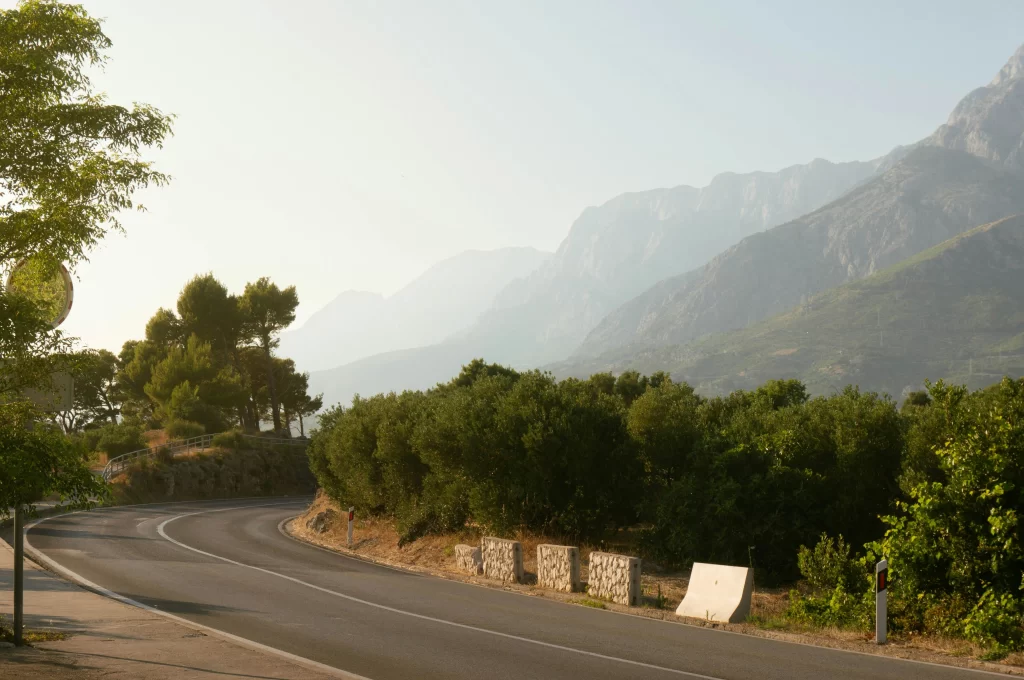Car Hire in Croatia 2025: Prices, EVs, Roads & Practical Tips

Why rent in Croatia (and when you shouldn’t)
There’s a certain freedom in cruising along the Adriatic with the windows down and the smell of pine and sea. Car rental in Croatia is more focused on freedom and relaxation than sheer driving dynamics (more on this later), but renting a car in Croatia is probably the best way to go about during your holidays.
With well‑maintained motorways linking Zagreb, Zadar, Split and Dubrovnik and (mostly) good signage, driving here is generally easy. Local roads can be narrow and winding, but that’s what you’re here for, anyway.
Renting makes sense if you want to go beyond one city, visit national parks like Plitvice, or take a coastal road trip. It’s less useful if your itinerary is strictly urban. For example, Dubrovnik’s old town is pedestrian‑only, and parking is expensive. In Zagreb, you can rely on trams and rideshares such as Bolt or Uber. If you’re hopping between islands, ferries require reservations, and a car can become a hassle. And if you’ve never driven a manual, be aware that automatics are rarer and pricier in Croatia.
Car rental costs: is it expensive?
Costs vary by season, rental company and car type. Daily rates for an economy model (e.g. an Opel Corsa) are around €60-90€ during peak season. Compact cars like an Opel Astra run €70–€100 in the peak. Luxury models, such as a BMW X5 or 5 series cost around €250–€350 in summer. The price includes VAT and basic insurance (collision damage waiver, theft protection, third‑party liability).
Extras will catch out the unwary. Budget €5–10 for an additional driver, €8–15 for a child seat and a young driver surcharge of €7–10. Taking the car on a ferry costs more, depending on the rental company. Planning to pick up in Zagreb and drop off in Dubrovnik? Most companies have a one‑way fee, ranging from €200 to €400 and more.
IMPORTANT: Automatic transmission cars cost about €15–€20 more per day than manuals.
Is car rental in Croatia expensive? Compared with bus tickets, yes, but when split between two or more people, it’s not that bad. Factor in tolls (see our highway guide), fuel and parking, and still you’re buying freedom. Consider it an investment, not daylight robbery.
Petrol, diesel, EV: what you’ll actually get
Croatia’s rental fleets are dominated by diesel cars, not because Croatians love diesel (which is true), but rather because diesel engines go further on less fuel. Most rental cars carry 40–50 litre tanks, roughly 11–14 gallons, and at current prices a full tank costs about $55–€70. Diesel costs about the same per litre as petrol but “lasts longer”, meaning you’ll spend less on fuel. Gas stations are plentiful, with locations every 20–25 km on highways and most local roads. Prices are slightly higher on the motorway than in town.
It’s also important to know that Croatian stations usually cheekily stock the premium fuel more than the regular ones to make you pay extra. I hate this so much, but there’s nothing to do about it, sadly.
As in many countries, petrol nozzles on gas stations are green and diesel nozzles are black.
Electric vehicles are an emerging option. EVs also come with perks: free charging at some hotels or shopping centers and government incentives like toll discounts. Daily electric car rental rates are hard to find easily since there’s a very small rental electric fleet. Some companies charge more than €500 for a day in a Tesla Model Y, for example.
Croatia’s EV charging network is expanding, and has grown around 40% annualy since 2020.Around two-thirds of chargers are AC, and one third are DC, with fast chargers usually located around motorways, with more than 60 locations with around 180 charging points available. Apps such as PlugShare or NextCharge help locate chargers. Unless you’re planning long rural detours where chargers are sparse, an electric car can be a stylish, sustainable choice.
Most rental fleets in Croatia offer a mix of compact hatchbacks, small SUVs, and the occasional sedan. Don’t expect anything fancy unless you’re in Split or Zagreb.
Best roads for a rental
Scenic drives worth the wheel:
- Rovanjska to Novi Vinodolski is one of my all-time greatest routes. Make sure to enjoy it if you can because it combines some of the best asphalt in Croatia with great bends, drops and views.
- Šibenik to Primošten: A bite-sized mini route that is fun, quirky, and has a lot of space to park and take a dip in the sea.
- Plomin to Opatija: From Croatia’s tallest structure in Plomin to the birthplace of Croatian tourism and racing, this road is historic, fun and beautiful to drive.
Routes to approach with caution:
- Mountain passes like Sveti Jure: Croatia’s highest paved road climbs to 1,744 m and requires reversing to let oncoming cars pass. It’s great fun if you want to be there, and stress otherwise.
- Mali Alan Pass and other unpaved routes: Paved only halfway, relatively unsafe for visitors and just a pain to get to, the Mali Alan Pass is a proper challenge. Please don’t go there in your Corsa.
- Rural island roads: On Hvar, the one‑lane tunnel between Pitve and Zavala is carved through solid rock and unlit. On Krk and other islands, some roads have sheer drops to the sea. Drive slowly and use the horn to alert oncoming traffic.
- Narrow village lanes: In many rural areas, the road can barely fit one car. On islands, roads are often very narrow. Local drivers may try to squeeze past; this is part of the initiation, feel free to be scared and scream, we don’t really care.
As a rule of thumb, stick to numbered state roads if you’re unfamiliar with the terrain, and save the mountain passes for your second or third visit and a car that isn’t an Opel Corsa.
Then again, use navigation on your phone because it’s probably more updated than the ones in the cars.
Tips for renting a car in Croatia
Even seasoned travellers can get caught off guard when renting a car in Croatia. Here’s what to watch for:
- Manual vs automatic: As mentioned, automatic cars are in limited supply and cost more. Reserve early if you can’t drive a manual. Rental companies know this, and have a good stock of automatics at any time.
- Security deposit and excess: The rental price includes basic insurance, but you’re still liable for a deductible of roughly €1,000–€1,200. This deposit is usually held on your card and released after return. The best idea is to ask the agency for as many details about insurance and similar topics before you sign anything.
- Hidden fees: Beyond the extras listed earlier, there can be surcharges for out‑of‑hours pickup, cross‑border travel and dropping off at a different location. Make sure the quote you see online includes everything you need.
- One‑way fees: If you’re planning a north–south road trip (e.g. Zagreb to Dubrovnik), confirm the one‑way fee up front, as it can be significant. For some, it’s still worth the cost: returning north to avoid the fee wastes time and fuel.
- Ferries and islands: You must usually declare at booking if you plan to take the car on a ferry; there’s often an extra fee, and some companies restrict island travel. Check whether your insurance covers water damage if the ferry hits a rough wave – it sounds absurd until you’ve seen the swells in December.
- Parking quirks: In most cities, parking is not free, and we use colour-coded zones to inform of the price. Fines for parking violations range from €30 to €100, and your rental company may also charge an administrative fee.
- Fuel policy: Most rentals use full‑to‑full; failing to refuel will result in a charge. Try filling up near the rental company and KEEP THE RECEIPTS.
Driving style vs car choice
Croatia drives on the right, but the unwritten rules are what catch foreigners out. Locals are confident, and almost everyone drives above the speed limit. Think of it this way: if the sign says 70 and there’s no houses nearby, you should drive 80. On highways, 140 is good. In town, try and move slow, but be quick off the line.
Around Zagreb and other major towns, you’ll find very high-quality highways. In rural areas, roads may be unlit at night; use your high beams and avoid long night drives. In mountainous areas and islands, the road may narrow to a single lane. Uphill traffic has the right of way. Always carry a fluorescent vest, warning triangle and first‑aid kit – they’re mandatory.
Winter driving (late October to April) requires daytime running lights and winter tyres; snow chains may be needed as well if traveling to remote areas.
When choosing a car, think like a local:
- Small is smart: For old town streets and villages, a compact car (Corsa, Polo, Peugeot 208) will save you stress.
- Manual if you can handle it: Manuals are plentiful and cheaper; if you’re comfortable with a stick shift, you’ll have more choice and save a bit.
- Luxury vs practicality: Renting a luxury car is a dumb idea for many reasons, but if you absolutely need the space, it’ll cost more than 2 smaller cars.
- Diesel vs petrol vs electric: When you pick up the car, double‑check the fuel type to avoid an expensive mishap.
Final thoughts from a Croatian
Driving in Croatia is about more than just A‑to‑B, especially on the coast. If you enjoy driving, we have tons of great routes and roads to offer, and many of those are only reachable if you have your own car and a bit of time on your hands.
If you ask how to rent a car in Croatia or whether it’s worth it, the answer is that it depends on your curiosity and patience. Yes, there are tolls, hidden fees and the occasional weird mountain pass.
In 2025, the country continues to invest in roads and EV infrastructure. The government aims to reduce accidents by enforcing safety regulations and improving signage. The types of rental cars in Croatia are diversifying, from city hatchbacks to Teslas, but most people still rent small cars.
One of the underrated Croatia driving tips? Drive defensively, check your fuel, keep small change for parking meters, and don’t bite off more than you can chew. Take it easy, but try and drive like a local, I hate getting stuck in traffic behind someone from a real country who respects the rules just a bit too much.
FAQ
It usually costs €25–50 per day outside summer, and €60–100 during July and August. Compact cars and manuals are cheaper, while automatics and SUVs can double the price.
Most rentals are petrol or diesel. EVs and hybrids are starting to appear, especially in Zagreb and on the coast, but charging stations are limited outside major routes and EVs are much more expensive.
Highways are the fastest way to cover distance, but coastal and mountain roads offer the best scenery. Routes like Split to Dubrovnik via the D8 or Zagreb to Rijeka through Gorski Kotar are popular choices.
Yes, but you need to confirm with the rental company. Many allow trips to Bosnia or Montenegro for an extra fee. Always check in advance.
Most companies require drivers to be at least 21, and some add surcharges for drivers under 25.
